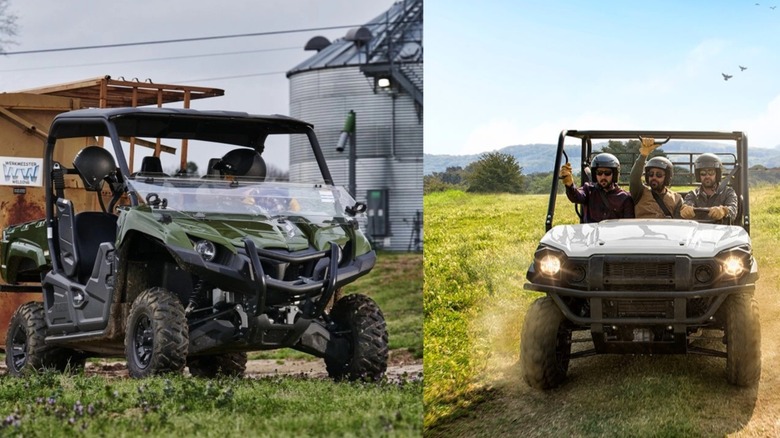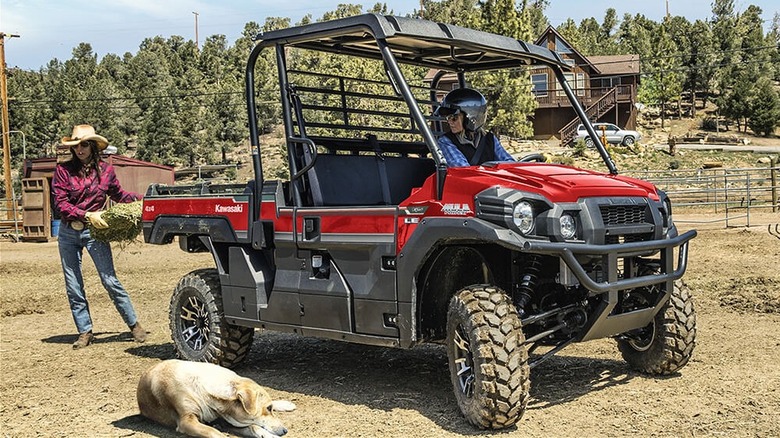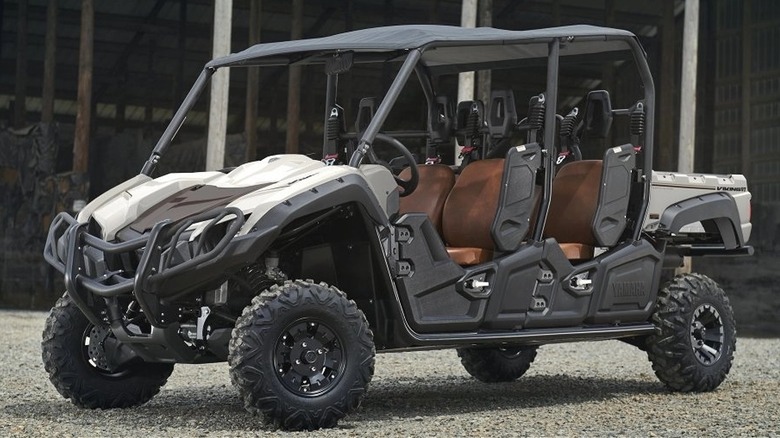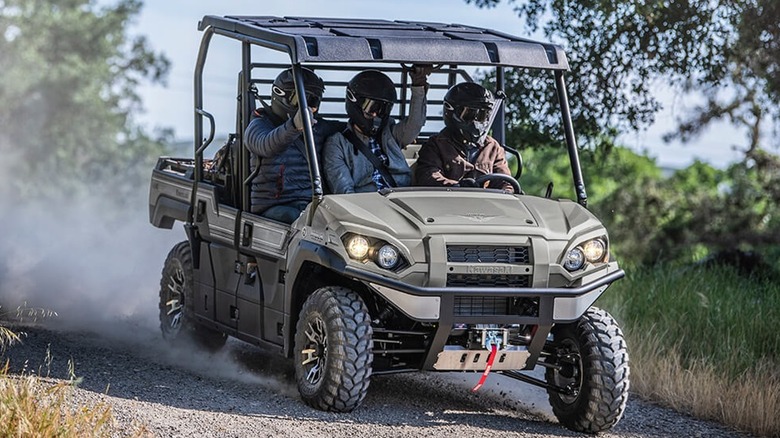Yamaha Viking Vs. Kawasaki Mule: What's The Difference Between These Side-X-Sides?
In the world of side-by-sides, the multi-use utility models have become the go-to for ranchers, farmers, and the construction industry. While you can still use these versatile machines for trail-riding fun, they also serve to help tackle challenging projects in places your average pickup might not belong. The Utility Terrain Vehicle market as a whole reached a whopping 6 billion in 2023, with no signs of letting up. Looking at two of the largest powersports manufacturers, how do Yamaha and Kawasaki stack up against each other?
Kawasaki has a lengthy history producing the Mule with a reliable and capable reputation. Yamaha hasn't been making side-by-sides for nearly as long, but is stepping up with some compelling alternatives to the competition. With several distinctions between these two UTVs — such as the number of models available, performance capability, cost and features — here is a breakdown to help you narrow down the right side-by-side that meets your needs, and doesn't destroy your wallet.
Viking EPS vs. Mule Pro-FX EPS LE
While the Mule family features 11 different models starting with a two-seat Mule SX, in order to compare apples to apples, the Viking EPS listed for $15,799 most closely lines up in price and features with the Mule Pro-FX EPS LE, offered for $14,899. The first notable contrast between the two models is the size and configuration of the engines: The Yamaha Viking EPS comes equipped with a 686cc 4-stroke SOHC 1-cylinder engine, whereas the Kawasaki Mule Pro-FX EPS LE offers an 812cc 4-stroke DOHC 3-cylinder.
Regarding off-road capability, the Yamaha design features enhanced ground clearance at 11.8-inches, compared to the lower Kawasaki at 10.4-inches. Both UTVs come equipped with a double wishbone suspension front and rear, but Kawasaki's unit features an extra half-inch of travel over the Yamaha. The Mule Pro-FX EPS LE also offers an extra inch of tire height and width over the Viking EPS. Ride height and terrain is important to keep in mind when getting ready for your first 4x4 off-road adventure.
How do these two side-by-sides function as work-horses? While the 1,500-pound towing capability of the Viking EPS is impressive, the Mule Pro-FX EPS LE has it beat with up to 2,000 pounds of pulling power. However, the Yamaha does offer a tilting bed for easy dumping, while this particular Kawasaki does not. However, you can equip several other premium accessories for your Kawasaki Mule to add similar (and additional) functionality.
Viking VI EPS Ranch Edition vs. Mule Pro-FXT Ranch Edition
The top Yamaha Viking model is comparable to the Kawasaki Mule Pro-FXT line. The Viking VI EPS Ranch Edition starts at $17,899, which is less than the Mule Pro-FXT Ranch Edition at an MSRP of $18,599. Both units offer the same engines listed in the previous matchup, but this time, they can each accommodate up to six people. In the case of the Ranch Edition trim, both come with extras. However, the Kawasaki side-by-side includes a powersport winch, whereas the Yamaha features extras like under-seat storage and a rear grab bar.
On rugged terrain, the Viking VI EPS Ranch Edition offers a configuration that provides both advantages and disadvantages. With a longer wheelbase of 115.6-inches, the Yamaha offers enhanced traction and more interior space. Although, the Kawasaki's shorter wheelbase of 92.3-inches does have the edge in terms of greater maneuverability, capable of a tighter turning radius for narrow trails. Despite being almost 24-inches shorter in length, the Kawasaki manages to tip the scales at 210-pounds more than the Yamaha, which could negate some of the power provided by the larger engine.
When comparing utility effectiveness, the Viking VI EPS Ranch provides up to 600 pounds of hauling power with several built-in tie-down hooks, and a tilting feature that can be engaged from either side. The Mule Pro-FXT Ranch Edition is capable of handling 999 pounds with three people onboard, and only 350-pounds with six people.
Which side-by-side is right for you?
For those looking for the most powerful option and need the ability to haul massive loads, the Kawasaki Mule is the obvious choice. While no slouch, the Yamaha Viking doesn't provide as much towing capacity and features a smaller engine. The larger 3-cylinder motor of the Mule also makes it a better choice for scenarios like thick mud, or faster trail riding, whereas the Viking might struggle to keep up.
If comfort is paramount, the Yamaha Viking — particularly the VI model — provides a more ergonomic and spacious cabin when compared to the Mule. Comfort is especially crucial for the middle seat passengers, and Yamaha's design provides additional room with three bucket seats instead of a bench, and tilts the middle seats back slightly for shoulder space. The Viking's chassis also allows for more space along the cabin floor for entering and exiting the vehicle more easily. Depending on your primary driving habits, especially if you're doing heavy off-roading, the Kawasaki Mule may be the better choice. Those who just need a multipurpose vehicle on ranch grounds or farmlands may want to opt for the Yamaha.



